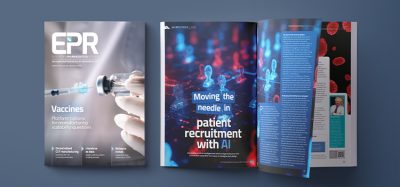Alternative routes of administration – a focus on oral biologics
Posted: 28 October 2020 | Nikki Withers (European Pharmaceutical Review) | No comments yet
A major challenge in achieving clinically relevant oral delivery of biologics is overcoming the multiple physiological barriers in the gastrointestinal tract. In this article Nikki Withers discusses these challenges with Shawn Davis, Head of Drug Delivery, BioPharmaceuticals Development, R&D at AstraZeneca, who shares some of the latest advances in drug design that are helping oral biologics become a reality.


What are the favourable aspects of oral formulations?
The most obvious benefit for the majority of patients is the simplicity and familiarity of this route of administration. Since childhood, many people have been taught that medicine comes in a pill that you swallow. That does not mean it is always easy, depending on the size, shape and surface of the pill or capsule, but it is familiar. Solid oral dosage forms often also have better storage stability and can impose fewer restrictions on how patients incorporate the medicine into their daily lives. Finally, oral formulations are particularly valuable when one is treating a disease for which the therapeutic target is in the gastrointestinal (GI) tract. In this case, the oral route gives the most direct access to deliver the drug to the desired target.
What are the challenges associated with oral biologics?
At the most basic level, humans’ GI system is a highly evolved mechanism for breaking down large molecules into smaller, easier to absorb molecules. Biologics are large complex molecules that depend on their structure to engage with targets for their therapeutic effect to be realised. So, putting this kind of molecule in a system that functions to destroy it results in a significant number of challenges that must be overcome. First and foremost, you need to protect the molecule from the harsh environment of the GI tract, which is quite acidic and filled with enzymes for breaking down the molecules. Then you need to find a way to allow these large molecules to pass through the multiple layers of mucous and cells lining the tract if the goal is systemic distribution of the molecule. If the target is in the GI tract this second challenge is slightly simplified but not eliminated. Finally, you need to ensure the molecule is absorbed in the correct part of the tract, which may be made more challenging by the methods you used to protect the molecule against the environmental conditions.
How is absorption/efficacy affected by oral administration?
Generally, the systemic bioavailability of an orally administered biologic is far lower than that of an intravenous or subcutaneously administered molecule. Typically, less than 10 percent of the dose administered is systemically available. This is due to all the challenges discussed previously, which an intravenous or subcutaneously dosed molecule would not experience. There is currently a great deal of focus on achieving improved bioavailability for oral biologics.
Can you discuss the importance of half-life and how biologics (eg, antibodies) can be engineered to have increased half-lives? What does this means for oral delivery?
The half-life of a drug is essentially how long it is available in the body to impact the target. Our bodies have multiple mechanisms for clearing molecules. The structure of the molecule, where it is administered and the timeframe over which it is administered can all play a role in this clearance. Ideally, we would like a molecule to remain at a therapeutically relevant concentration at the site of action for as long as necessary, allowing a patient to receive the full benefit of the therapy with the fewest possible repeat doses. There are a few instances in which we might want frequent dosing to allow us to stop the treatment, but in general the fewer pills, injections or time in a clinic, the better for the patient. There are multiple opportunities for us to influence the half-life of a drug. The engineering of the molecular structure itself plays a major role from the outset. Beyond the structure we can control the half-life by formulating the molecule with other materials that slow its clearance from the body. This may be another molecule that reversibly binds and protects the drug from clearance, a polymer or inorganic matrix that we load the molecule into or even materials that change from liquids to gels once they enter the body. In each case, the material is protecting our active ingredient and preventing or slowing its clearance.
There is currently a great deal of focus on achieving improved bioavailability for oral biologics”
Finally, we can use the rate of administration to control the clearance. This might be using the formulation approaches I just mentioned, as they slowly elute the drug or dissolve over time, or it might be a device that slowly releases the drug over longer timeframes. The low bioavailability of orally-dosed biologics means we have even less active drug getting into the system than via other routes of administration. So, whatever drug that does get into systemic circulation is all the more ‘valuable’ to protect from fast clearance. While half-life is important, the current focus for oral biologics is typically more about achieving improved bioavailability.
Can you discuss advances in drug design and coatings that are helping oral biologics become a reality?
The traditional approaches to addressing the barriers include engineering molecules that are more stable and can resist enzymatic degradation, the use of enteric coatings to protect the active ingredient and time the release of the payload and small molecule excipients that enhance the permeation of the drug through the mucous and epithelial layers of the GI system. These have been used either individually or in combination in hopes of both protecting the biologic molecule and allowing it to pass into the circulatory or endocrine system.
Syringes mechanically penetrate the skin to deliver biologics, so perhaps this same approach could by engineered for use in an oral dosage form”
The industry’s collective understanding of the science of these approaches has evolved over the past several decades, but the overall success rate has remained low. Given the low success rate many groups are now focusing on alternative approaches. Some are using mechanical penetration enhancers rather than chemicals. For example, syringes mechanically penetrate the skin to deliver biologics, so perhaps this same approach could by engineered for use in an oral dosage form. Several groups have proposed and demonstrated delivery in pre-clinical models for tiny arrays of needles within capsules, while others have built jet injectors that can force the liquid drug through the GI tissue without the use of a needle. As you can imagine, these systems can become complex and there is still a lot to prove in this area. Other groups are looking to nature for inspiration. There are a number of pathogens that infect people after being ingested. Understanding how these pathogens manage to survive this harsh environment and spread systemic toxins may point to new opportunities to deliver therapeutic molecules.


What are you currently focusing on at AstraZeneca?
At AstraZeneca our focus is on developing dosage forms that optimise patient convenience while also ensuring we deliver the best possible therapeutic outcome. We have several early-stage programmes that are exploring the potential oral delivery of biologics. For these programmes, we combine our internal biologics expertise with collaborations with external partners who are exploring novel approaches.
Finally, what research in the field are you particularly excited by?
My team has a specific focus on very large molecules for which the challenges of oral delivery are likely the highest. With that in mind, we are focused on the potential of addressing targets directly in the GI tract. There are a number of targets for diseases that manifest themselves both in the GI as well as systemically, particularly when it comes to inflammation. I am excited about the potential to address some of these diseases by delivering drugs directly to these targets, with the aim of maximising the therapeutic benefit while minimising the systemic side-effects, all in a patient convenient dosage form.


After gaining a PhD in Chemical Engineering from the Georgia Institute of Technology, Shawn Davis has spent almost two decades exploring the application of drug delivery technologies with the aim of improving the lives of patients. He has split his professional career between start-up companies and well-established biopharma companies like AstraZeneca and Amgen. At AstraZeneca, Shawn leads the drug delivery team in BioPharmaceuticals Development, R&D. His role involves leading a team of scientists to understand the needs of the company’s evolving portfolio and developing drug delivery systems to address these challenges. Shawn has generated 12 issued US patents and has published several articles in high impact journals. His graduate lab was among the first to generate and publish results of microneedle mediated drug delivery. Shawn regularly speaks at leading conferences on industry trends, product development and technology innovation.
Issue
Related topics
Biologics, Drug Delivery Systems, Research & Development (R&D)









